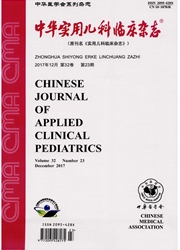

 中文摘要:
中文摘要:
目的 检测1例家族性高胆固醇血症(FH)并冠心病患儿低密度脂蛋白受体(LDL—R)基因点突变,分析基因型与临床表型间的关系,探讨该病发病的可能分子机制。方法先证者,女,11岁。以肘、膝、踝关节处有黄色瘤、双眼有明显角膜弓,频发劳累时胸痛为主诉入院。以患儿及其父母的基因组DNA为模板,用降落PCR方法,在同一程序中扩增LDL—R基因的启动子和全部18个外显子;单链构象多态性(SSCP)分析PCR扩增产物,对有异常SSCP带型的PCR产物进行DNA测序;采用PCR—DNA测序技术,检测载脂蛋白apoB100基因Q3500R突变,以排除家族性apoB100缺陷症。结果 该患儿及其母亲第14外显子发生Pro664→Leu(P664L)杂合错义突变,其父未发现该突变。未检测出患儿及其父母apoB100 Q3500R突变。结论此患儿为LDL—R基因存在P664L杂合错义突变,来自其母;该突变可能是FH的致病突变。
 英文摘要:
英文摘要:
Objective To screen the point mutation of low density lipoprotein receptor (LDL- R) gene in a child with familial hypercholesterolemia (FH) and coronary heart disease,and explore the relationship between the genotype and phenotype, and discuss the molecular pathologic mechanism. Methods A child with clinical phenotype of homozygous FH as well as his parents had been investigated for mutations of promoter and all eighteen exons of LDL - R gene. Screening was carried out by using Touch - down polymerase chain reaction(PCR) and single strand conformation polymorphism(SSCP) ,combined with DNA sequence analysis. In addition,the apolipoprotein B gene (apoB) for known mutations (R3500Q) that cause familial defective apoB100 (FDB) was screened by PCR - DNA sequence analysis. Results A hyterozygote mutation in exon 14 of the LDL - R was identified in the proband (P664L) and her mother but not her father. No mutations R3500Q of apoB100 were observed. Conclusion The identified mutation cosegregated in the family members and is thought to be causal for the FH phenotype.
 同期刊论文项目
同期刊论文项目
 同项目期刊论文
同项目期刊论文
 Mutations in the LDL receptor gene in four Chinese homozygous familial hypercholesterolemia phenotyp
Mutations in the LDL receptor gene in four Chinese homozygous familial hypercholesterolemia phenotyp Noninvasive Evaluation of Coronary Flow Velocity Reserve in Homozygous Familial Hypercholesterolemia
Noninvasive Evaluation of Coronary Flow Velocity Reserve in Homozygous Familial Hypercholesterolemia EVALUATION OF CORONARY FLOW VELOCITY RESERVE IN HOMOZYGOUS FAMILIAL HYPERCHOLESTEROLEMIA BY TRANSTHO
EVALUATION OF CORONARY FLOW VELOCITY RESERVE IN HOMOZYGOUS FAMILIAL HYPERCHOLESTEROLEMIA BY TRANSTHO 期刊信息
期刊信息
